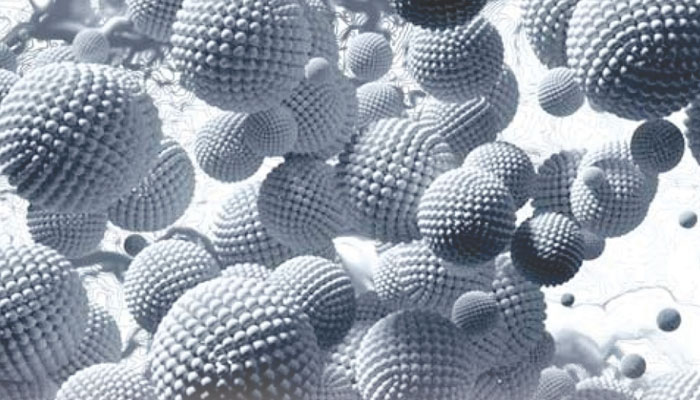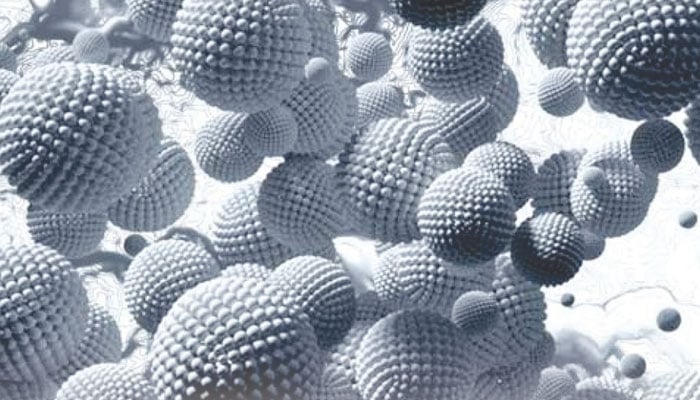
Where man has lost the organic components around him in the scientific development, whether they are obtained from plants, trees, herbs and animals or available in any other form and form from the earth and mountains. Such as oil or gas deposits or very old organisms that once lived on this planet and are discovered in the form of structures. But inorganic elements have also been discovered and used in various ways. One of the most rapidly advancing research fields is that of nanoparticles. One ten millionth of a meter is equal to one nanometer.
A nano particle has a size of one to hundred nanometers, due to this size, some special and unique properties are created in the nano particles. These particles can be made of different materials such as metals, polymers or multi-molecular compounds and organic molecules such as lipids or fats. These particles are widely used in medicine, electronics and other fields. The size and composition of these particles determine their properties, so they can be easily tailored for specific tasks. The very small size of nanoparticles allows them to enter human cells and tissues.
This feature makes these particles useful for delivering drugs and other therapeutic molecules to specific target intracellular locations. A very interesting application of these three particles relates to snake venom. The combination of snake venom and nanoparticles holds the promise of advancing our understanding of both fields and developing new treatments for snakebites and other medical conditions. Snake venom is a complex mixture of toxins.
Research has shown that nanoparticles can be used to deliver snake venom into cells, helping to better understand its mechanism of action and to develop new treatments for snakebite victims. Moreover, some venoms of snake venom have therapeutic properties such as anti-blood thinning or anti-coagulant, anti-inflammation, anti-inflammatory, etc. Different single drugs can be used with the help of nanoparticles to increase their effectiveness and specificity. Thus, snake venom can be used as different single drugs. It is a mixture, but it contains the largest amount of different moments or proteins.
They also contain many enzymes or non-enzymes. These moments are actually the active part of any snake venom. The combination of toxins and nanoparticles can occur in several ways. By encapsulating toxic substances in nanoparticles, for example, researchers can control the release of these substances and tailor them to a specific target. Similarly, nanoparticles can be used to make antidote for snake venom, which can be more effective in neutralizing the toxic effects. Recent research has also shown that certain nanoparticles can neutralize snake venom by themselves.
Testing of tinium oxide nanoparticles has shown that mice do not show symptoms of snake envenomation if the venom is mixed with these particles and injected into mice. Similarly, various research studies have been done with silver nanoparticles. As mentioned above, efforts are being made to use nanoparticles as an antidote to snake venom, but so far such therapeutic approaches are largely limited by the efficacy, size, and specificity of nanoparticles. May be limited by scarcity. Therefore, research is ongoing to reduce the toxicity of toxic substances by encapsulating them in nanoparticles.
Similarly, the components of snake venom that reduce heart disease, blood thinning and internal inflammation of the body are also being tested with the combination of particles. The same strategy is being used against cancer cells and this treatment method is also being studied in depth. These are some examples of drugs that are in various stages of development using snake venom and nanoparticles. It can be said that these are early stages and hence more research is going on. This research on snake venom and nanoparticles is very important for the future.
For example, in areas of the world where the incidence of snakebites is high and not everyone can afford the treatment, antidote in nano-particle capsules would prove to be a cheap and effective treatment. The same method can be used in other medical conditions as well. For example, a toxin or other drug can be encapsulated in nanoparticles to specifically target cancer cells. The use of nanoparticles in the field of medicine itself has become a rapidly advancing subject known as nanomedicine. Like snake venom, scorpion venom also contains biologically active compounds and nanoparticles are being studied along with these compounds. Such research is being done for medical conditions such as pain, cancer and inflammation.
Studies are also underway on the use of nanoparticles as an antidote to scorpion venom, and just like snake venom, nanoparticles have shown the ability to effectively neutralize scorpion venom. Some other common uses of nanoparticles that are non-toxic include diagnostic and imaging applications such as X-ray and MRI, speeding up chemical processes, energy storage devices and in electronics, materials. In science, they are also being used in making computers, displays and solar panels. This is because the addition of these particles increases the strength, durability, workability and other properties of any material.
This is the reason that nanoparticles are being used in cosmetics. Such as sunscreen creams and toothpastes etc., are being used in food packaging and also to extend or improve the shelf life or safety of food products. In time, the application of nanoparticles in everyday life will increase greatly, as many potential new uses are being discovered all the time. Research on nanoparticles is going on in Pakistan, since these particles are becoming important in various fields of technology, therefore, researchers in the field of electronics, medicine and material science in Pakistan are activating the potential of nanoparticles for various possible practical fields. Looking for.
Researchers from several universities in Pakistan are working on the development of new materials, the use of particles for drug delivery, and studies of the toxicity and safety of the particles themselves. Apart from this, our country also has private companies and research institutes involved in the development and commercialization of nano-based products and technologies. This sector has the potential to play an important role in various industries of the country. If we talk about snake venom and nanoparticles, there is no adequate work in Pakistan in this field. However, it is possible.
As Pakistan and subcontinent are also home to poisonous snakes, in which cobra, krait, Lindhi and Russell viper are four big poisonous snakes. A lot of research has been done on the venom of all these snakes. Recently, the field of snake venom and nanoparticles has attracted the attention of many researchers and a joint effort of University of Karachi and Davy University is underway in this direction. Proposed activities are being organized in various directions keeping in mind such studies at the international level. Attempts are being made to compile this research into a form that will ultimately lead to a very useful therapeutic approach.
Nanoparticles will also be tested as an antidote to snake venom, and various compounds and molecules of the venom will also be tested therapeutically. Nanoparticles have been described in several research papers as an antidote to poisons or alone. Nanoparticles can be very useful in terms of antidote for snake venom. The future of research on snake venoms and particles is full of possibilities. The information so far has increased our understanding in that many processes at the cellular level have provided new information. This information is providing a basis for future research.
Both of these areas have bright potential to advance our understanding and develop antidotes to poisons or treatments for other medical conditions that may be even more useful and effective due to the potential of increased technology. The field of nanoparticles will become very important in Pakistan in the near future and our country will play its role at the international level in this field.
setTimeout(function(){
!function(f,b,e,v,n,t,s)
{if(f.fbq)return;n=f.fbq=function(){n.callMethod?
n.callMethod.apply(n,arguments):n.queue.push(arguments)};
if(!f._fbq)f._fbq=n;n.push=n;n.loaded=!0;n.version=’2.0′;
n.queue=[];t=b.createElement(e);t.async=!0;
t.src=v;s=b.getElementsByTagName(e)[0];
s.parentNode.insertBefore(t,s)}(window,document,’script’,
‘https://connect.facebook.net/en_US/fbevents.js’);
fbq(‘init’, ‘836181349842357’);
fbq(‘track’, ‘PageView’);
}, 6000);
/*setTimeout(function(){
(function (d, s, id) {
var js, fjs = d.getElementsByTagName(s)[0];
if (d.getElementById(id)) return;
js = d.createElement(s);
js.id = id;
js.src = “//connect.facebook.net/en_US/sdk.js#xfbml=1&version=v2.11&appId=580305968816694”;
fjs.parentNode.insertBefore(js, fjs);
}(document, ‘script’, ‘facebook-jssdk’));
}, 4000);*/



